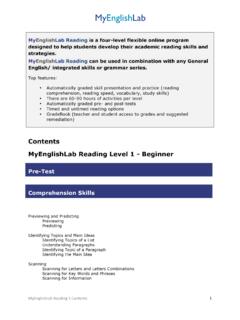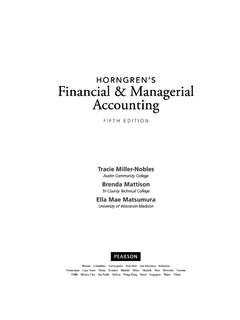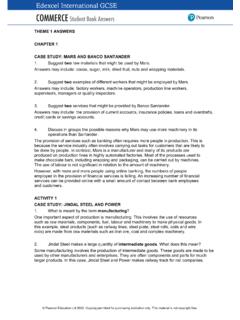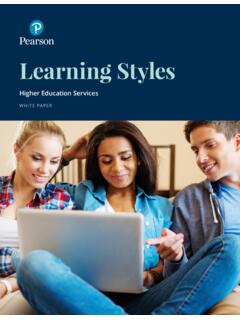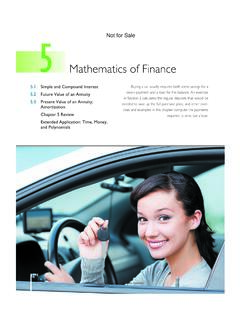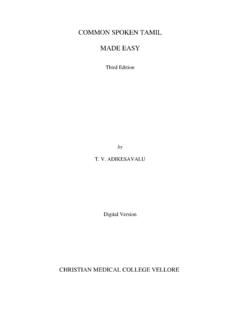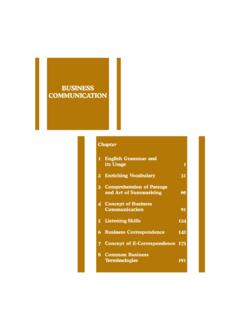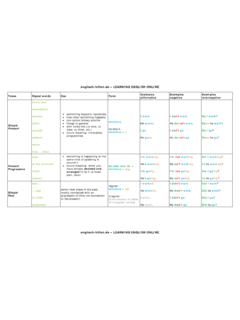Transcription of Benchmark Test - Pearson
1 Benchmark TestGain thorough insight into your students skills, measure their progress in detail and receive targeted direction for your teaching in just 45 ContentsFacts 3 Introducing the Pearson english Benchmark Test 5 Why Choose the Benchmark Test? 6 The Benchmark Test Experience 8 Score Reports 102 Type of testProficiency and progressLearnersAge: 14+Levels available: All levels (CEFR <A1-C2; GSE 10-90). 4 test levels available for CEFR bands A, B1, B2, C. Type of english : General International EnglishDeliveryLength: 45 minsWhen: AnytimeWhere: Online, at home or in the classroom*Admin platform: Pearson english assessment portalMarkingMarked by: Pearson english AI technologyResults returned: Within minutesResultsPrimary score: GSEO ther scores: CEFR Additional insights: Detailed performance summary for each skillRecommendations for teachers and students Mapping to Pearson english coursewareComplementsLevel Test Suitable for any course* Suitable test environment required, including PC, headset with microphone boom and Internet connectivity throughout.
2 Test location to be specified by Test Facts34 Introducing the Pearson english Benchmark TestThe perfect companion to any english teaching programme, measuring progress in detail and offering tailored direction for both students and teachersEvery language learning journey is unique. The Benchmark Test from Pearson english takes the time, complexity and subjectivity out of the assessment process, making it quick and easy to measure real progress thoroughly, accurately and by years of expert research, this straightforward yet powerful tool can be used alongside any english course, delivering the clarity, personal guidance and motivation to smooth and accelerate the journey to the Benchmark Test across all students, classes, levels and even schools, to gain comparative insights that can help to optimise your entire teaching Benchmark Test is powered by Pearson english s market-leading artificial intelligence technology and administered through a powerful assessment portal, which offers.
3 A complete solution that helps you to track and compare results within a single english proficiency assessment ecosystem for successful, lifelong learning. Backed by years of expert research, this straightforward yet powerful tool can be used alongside any english ASSESSMENTUSE WITH ANY COURSEWhy Choose the Benchmark Test?Fast, efficient and easy to useFitting neatly into a 45-minute lesson, this test has been designed to give the most useful information about your students language progress in a way that enhances, rather than disrupts, the learning long as test takers have a computer, headset and Internet connection, the test can even be taken at home and results are returned in insights and directionThe Benchmark Test thoroughly assesses Speaking, Listening, Reading and Writing, with clear, at-a-glance visual and numerical data returned for individuals and groups, as well as more detailed descriptions of ability in each results also include tailored study guidance for each student, and recommendations for teachers on how to focus their classes.
4 With direction to the specific courseware and activities that can and reliableBacked by Pearson s leading artificial intelligence scoring technology, the Benchmark Test offers a choice of levels to support all students: A, B1, B2 or C. Questions focus on abilities relevant to that level to provide detailed, reliable are based on the Pearson Global Scale of english (GSE) as well as the CEFR, meaning progress can be measured in small increments within each complete assessment solutionThe Benchmark Test works alongside the Pearson english Level Test to track student progress in detail after having placed them in the correct class based on their abilities. Tests are administered and results managed via our state-of-the-art assessment portal. Through its smart tagging system, this powerful platform also allows you to measure performance flexibly across students, classes and teaching programmes, and throughout the learning journey.
5 6 The Global Scale of EnglishThe GSE is the first truly global english language standard. Based on a scale of 10-90, the GSE extends the Common European Framework of Reference for Languages (CEFR) by describing language ability at a much more granular level, allowing for more targeted assessment and remediation. Backed by research involving 6,000+ teachers from over 50 countries, the GSE is widely used by educators worldwide, helping raise standards in the teaching and learning of english . Find out more at Benchmark Test ExperienceStudents are presented with a wide range of question types, to give them the chance to demonstrate their skills in different ways. Questions target individual and integrated skills. From filling in word gaps and completing reading comprehension exercises to describing a picture and replying to spoken prompts, the Benchmark Test assesses the full extent of students abilities at the given level.
6 Here are a few examples:Fill in the vocabulary table complete the dialogueRead and give short answer8 Listen and repeatDescribe pictureWrite short essayListen and then speakCorrect grammar error9 GroupENGLISHC lass CapabilitiesStudents at this level can use an appropriate range of words, structures and phrases for familiar and everyday forms of writing. They can read a simple text and extract factual details. They can understand short, basic descriptions of familiar topics and situations, if delivered slowly and clearly. They can communicate in routine tasks requiring simple, direct exchanges of information. They can write a simple text containing key information, or short descriptions of people and favourite objects/possessions using basic connectors, given a ReportBENCHMARK TESTI nstitution: The Pearson School of EnglishStudents: 30 Students31/07/2018 - 24/01/2019 LISTENING5987BL61425858376950 AVERAGE31618312*62*38*525268*52*LEVELAB2 CAB2AB1B1B2B1 NAMEREADING61771060NS4343197458 SPEAKING668012BL3454543061 NSWRITING5888126538535338BL48 REPORTSPENNEY DUBRAYSUZY CODYLELAND FEHRENBACHMAURITA GRANDYKARREN BATEOFELIA DUDASHDELENA DUBRAYGALE GRANDYWILLARD GRIMMERJORIS LARSENRows per page:101-10 of 30 PERFORMANCE SUMMARYRECOMMENDED ACTIVITIESS tudents can generally understand the main information in simple conversations or narratives about familiar everyday activities, hobbies and interests.
7 They are able to identify key factual information ( prices, times and dates) from a recorded message and understand short basic descriptions of familiar topics and situations. Extend the range of topics covered and introduce new grammar and vocabulary accordingly. Give simple exercises comparing and contrasting two texts and asking students to identify where they took place and who was speaking. Integrated Listening/Reading: matching recordings of short texts with their contexts in descriptions. Do whole class exercises on guessing the meaning of unfamiliar : 36 SUGGESTED GSE LEARNING OBJECTIVESCan understand short, basic descriptions of familiar topics and situations, if delivered slowly and follow a simple conversation or narrative about familiar, everyday extract key factual information such as prices, times and dates from a recorded phone SUMMARYRECOMMENDED ACTIVITIESS tudents can generally follow the sequence of events in a simple text.
8 They are efficient at understanding a simple text about the past. They can understand short, simple personal emails/letters/narrative texts but struggle with extended texts or narratives. In a short text, they can understand basic opinions expressed in a simple language and make basic the students to read a short story and predict what they think will happen next. After a pre-reading prediction task students skim the text and confirm which of their ideas are confirmed in the text. Use true/false sentences about information and opinios from a text. Students underline facts and opinions in different colours in a text and feedback to the class on how they know the difference. Practice identifying specific information in a simple letter or brochure. Choose two different texts on the same familiar topic and ask them to identify similarities and differences in the facts , guided by questions.
9 Reading: 38 SUGGESTED GSE LEARNING OBJECTIVESCan understand short, simple personal emails and make basic inferences from simple information in a short identify specific information in a simple factual identify specific information in simple letters, brochures and short SUMMARYRECOMMENDED ACTIVITIESS tudents at this level can generally write simple sentences about themselves (personal details, what they and other people do or can't do, work and duties, personal skills, and their feelings). They are able to use simple linking words ( 'and', 'but', 'so' and ' then'). They can write a standard greeting card, basic directions, and simple plans/arrangements on a calendar or diary. They struggle to write about the topics that go beyond their immediate world. Presentation and practice of new verb tenses , within a greater range of relevant topic areas.
10 Begin to use student generated functional language brainstorm ways to give instructions, directions, etc. Writing: 40 SUGGESTED GSE LEARNING OBJECTIVESCan give personal details in written form in a limited write a few basic sentences to introduce someone and give basic personal information about write short, basic descriptions of everyday activities, given a SUMMARYRECOMMENDED ACTIVITIESS tudents at this level can generally use a range of simple language with more confidence to produce more developed spoken contributions. They can communicate longer stretches of connected clauses and functional language ( compare/contrast; reason/explanation). Develop activities designed to encourage students to consider and speak about the outside world. For instance, a short talk about someone/somewhere famous, followed by a question and answer session.
